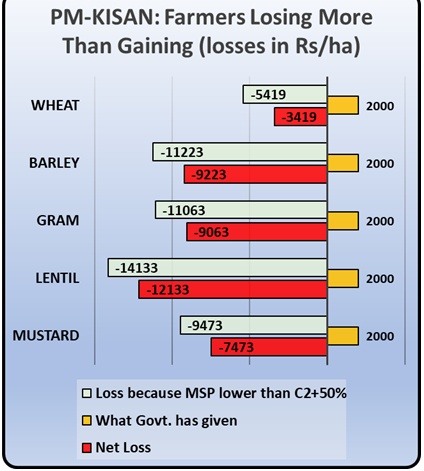PM-KISAN: Why Farmers Are Unhappy With Rs 2,000

Image Coutesy: Top News Wood
Prime Minister Narendra Modi electronically transferred Rs 2,000 to the bank accounts of 1.01 crore farmers on February 24 at a function in Eastern UP city of Gorakhpur. He also interacted with a selected group of farmers through video conferencing. He derided the Opposition for distributing ‘revari’ (small sweets) implying that what he was distributing was much more.
The transfer is supposed to be the first instalment in an income support scheme called PM-KISAN, under which a princely sum of Rs 6000 will be given out to small and marginal farmers numbering about 12.5 crore.
Since the scheme was cooked up with just weeks left before the process for this year’s Lok Sabha election kicks off, it is being transparently seen as an electoral ploy, meant to assuage farmers who have been agitating for most of Modi’s tenure for better prices and complete debt waivers.
The billion dollar question is this – is this last minute scheme really going to pacify the resentful farmers? Analysis of the economics of common farmers shows that it is unlikely to deliver much relief to the farmers and hence, it may not translate into any significant political gain.
Have a look at the chart below which summarises the loss and gain for farmers sowing five important rabi (winter) crops that are currently being sold in markets. It shows what the government has refused to provide and what it has provided.

Under Modi’s leadership, the BJP had promised in its manifesto for the 2014 general elections that it would implement the Swaminathan Commission’s recommendation that farmers should be given minimum support price (MSP) which is 50 per cent more than their total cost of production (called C2). This includes not only input costs, but also imputed costs of family labour, rent and interest on capital.
Take the case of wheat, the biggest rabi crop. The average total cost (C2) is put at Rs 1,339 per quintal by the Commission on Agricultural Costs & Prices (CACP) for the rabi marketing season of 2019-20. Adding 50 per cent to this to bring it in line with the Swaminathan Commission would bring the price payable to farmers to Rs 2009 per qtl. Since average yield of wheat, as per the agriculture ministry, is 32 qtl/hectare, so the average price that a wheat farmer with one hectare of farm land should be getting is Rs 64,593 per hectare. What he/she actually gets is Rs 59,174. That leaves the farmer with a dead loss of Rs 5419.
Now, if this farmer gets Rs 2000 from Modi’s scheme, he is still facing a loss of Rs 3419 per hectare. The exact loss will vary according to his land size, and also according to where he is residing because yields are widely varying between states. In the calculation, an average has been taken for the sake of clarity.
Losses on this score will increase in case the farmer is sowing other rabi crops like barley (jau), lentil (masur), gram (chana) or mustard (sarson). This is because MSPs are not as high proportionately as they are for wheat.
In short, just for one crop season, the farmers’ losses are still enormous, and Modi’s ‘income support’ is really nothing but ‘revari’ once again, in a different form.
Had the government accepted the widespread demand for MSPs to be fixed at C2+50%, farmers would have benefitted far more. But Modi wanted to have more optics, and less actual benefits, since the government is spending through its nose on giving concessions to the corporate sector, and has little care or concern for the hapless farmers.
It must be cautioned here that the above calculation is for MSP only which is available for the farmers who sell their produce to the government procurement agencies. In the case of wheat, this is a substantial portion of the total production but in all other produce, only a small fraction of farmers sell it to the government because the machinery is just not there. In such cases, the MSP is notional as prices available to the farmers are much lower than the MSP. And, for small and marginal farmers, the financial crunch is so great that they sell the produce as quickly as possible to whoever is willing to pick it up – even if the prices are abysmal.
Modi’s dole is thus unlikely to please the farmers very much. In fact, reports from across the states indicate that farmers are even more resentful that such a meagre sop has been offered to them after so much grandstanding.
Also watch: Sugarcane Farmers Drown in Debt in Western UP
Get the latest reports & analysis with people's perspective on Protests, movements & deep analytical videos, discussions of the current affairs in your Telegram app. Subscribe to NewsClick's Telegram channel & get Real-Time updates on stories, as they get published on our website.
























